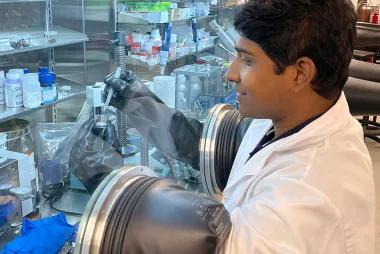Design + Innovation Day 2021 projects now viewable online

Since 2017, UBC Engineering has celebrated its students’ creativity — and often ingenuity — at an annual event called Design + Innovation Day.
The event showcases a dizzying array of research and technology produced by student teams during the previous academic year. Typically presented in the form of posters, design models and working prototypes, the projects tackle a diverse range of engineering problems identified by real-world companies and research laboratories.
In the past, this work would be exhibited over the course of a single day on campus to an audience of UBC community members, industry professionals and the broader public. Due to the pandemic, this year’s event took place entirely online — and now anyone can access most of the dozens of projects through a central website: Design + Innovation Day 2021.
“Every year, I am frankly awed by the talent and inventiveness on display during Design and Innovation Day, and this time was no exception,” says Dr. James Olson, dean of the UBC Faculty of Applied Science. “The work our students have produced over the last several difficult months is an inspiration, and further demonstrates that UBC Engineering graduates are prepared to become true leaders in their fields.”
An autonomous wildfire detection system, a wearable fetal movement monitor, a device that can significantly extend the shelf life of food and a method to transform pine trees into graphite for electric vehicle batteries are just a few of the innovations that student teams developed this year. They all share a common goal: to improve the well-being of people, places and the planet — the guiding vision of the UBC Applied Science Strategic Plan.
Being unable to work in the same room, however, presented participants with certain difficulties — difficulties now familiar to students and instructors impacted by the pandemic around the world.
“So much of our capstone course is about working closely with the students: brainstorming with them at the whiteboard, sketching up designs and concepts, showing them how to use rapid prototyping tools and reviewing and testing prototypes at the bench,” says Dylan Gunn, director of the UBC Engineering Physics Project Lab. “We had to give up a lot of this activity, and this has certainly had an impact on the student's experience.”
Yet by focusing their efforts on the process that precedes the construction of a physical prototype, the teams discovered unexpected benefits.
"Sometimes you've exhausted your theoretical understanding and intuition and the only way to move forward is to build and test a prototype," says Gunn. "But usually significant progress can be made by thinking carefully about the design, leveraging your theoretical knowledge and soliciting feedback and input from a wider variety of people, including experts.
“So this year we focused more on those design aspects, and less on the prototyping. All of our projects achieved meaningful results — and we likely managed to achieve these results with less material and energy than would have been used in a regular year. We'll be reviewing this approach to see what we want to carry forward into future years.”
For Jon Nakane, program director at UBC Integrated Engineering, a key priority was to help team members realize a unified vision without ever meeting in person.
“The challenge was to pull together all of the different project components and contributions from the students — some physical and some purely virtual — and create something that people would experience as a cohesive whole,” says Nakane. “How do you get people to see what your team has accomplished when the parts and contributions reside in different parts of the world?”
Again, the teams managed to surmount these obstacles, preparing video presentations that clearly expressed how all the elements of their projects — physical items, software, simulations — would ultimately come together.
While most of the engineering programs chose to post recorded presentations online for attendees and judges to view and evaluate, the Department of Chemical and Biological Engineering (CHBE) hosted a live, interactive online event — one that demonstrated how effective such a format could be.
The CHBE teams’ presentations, delivered simultaneously in different breakout rooms, were attended by over 100 students and lecturers, 17 industry judges and approximately 120 alumni, faculty members and other general attendees, some of whom were located in cities like Toronto and Boston. Indeed, for all programs a major benefit of moving online was gaining the ability to share students’ work with a wider audience than ever before.
The UBC Engineering capstone program aims to strengthen not only students’ technical skills and knowledge, but also their ability to manage projects, communicate and work as a team.
At the same time, the program benefits industry and academic partners — as well as the communities they serve — by providing potential solutions to problems they are facing. Capstone students may also offer community partners a low-risk means of exploring products and services that they may not otherwise have had the capacity to pursue.


